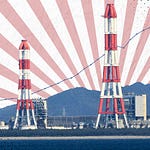
Hey Power Japan readers,
If you haven’t seen the New Year’s announcement post I sent you a few days ago, you should. It should make for an enjoyable reading and listening!
With the next iteration of Japan’s landmark energy strategy approaching its final form, I’m diving into the nitty-gritty of what its draft says about how the Japanese energy system is likely to evolve by 2040.
Here is the first in a series of five posts I’m planning.
What would you do when the government of the 4th largest economy and the 6th biggest greenhouse gas emitter in the world unveils its plan for how to power the nation for the next decade and a half?
Why, you’d read it, think about it, and tell everyone about it.
Come along with me for the ride.
On December 17, an advisory committee in the Ministry of Economy, Trade and Industry (METI) published a draft of the 7th Strategic Energy Plan. We’ll call it SEP for our purposes here.
This is a highly anticipated draft, closely watched by energy industry insiders and climate advocates alike and a subject of some debate during the Liberal Democratic Party and Lower House elections last year.
Why the anticipation? Because it wrestles with at least three big trends that are shifting the ground on which Japan’s energy policy is precariously built: growing energy demand, intensifying need to address the climate crisis, and the uncertain geopolitical terrain.
Climate advocates and some energy policy analysts have criticized the SEP for a number of reasons. Chief among them is that, given Japan’s huge renewable energy potential, the SEP falls short in its ambition for ramping up renewable energy and phasing down fossil fuels. There’s also an argument that its targets for renewables and fossil fuels are vague, making it hard for companies and investors to put money into energy projects over the medium and long term.
As much as I’m persuaded by these critiques, in this and the following posts, I’d simply like to bring the contents of the SEP to light. So, for now, I’m going to withhold my judgment, opting instead to explain the actual numbers and the thinking behind them.
This will be a series of five deep dives on the 7th SEP, one post for each major category of electricity generation source. The topics of the five posts will be as follows:
All pressures point toward energy diversity: As we’ll see in this post, in the minds of Japan’s energy policymakers, the need for a diverse energy mix is overdetermined. That means every relevant factor — recent changes in the global energy landscape, rising domestic electricity demand, technological uncertainty, and the pressures to decarbonize — strengthens their case for using all energy sources. At the same time, the numerical targets for the shares of renewables and fossil fuels in 2040 give policymakers an escape in case renewable deployment doesn’t proceed as anticipated.
Nuclear is the big winner: In a marked departure from the last SEP published in 2021, nuclear energy is back on center stage. For those of us following the discourse around GX (Green Transformation) under the Kishida Administration, this comes as no surprise, although this does appear to betray current Prime Minister Ishiba’s wish to reduce reliance on nuclear in the long term.
Renewables are relative winners: The 7th SEP repeatedly emphasizes the need to make renewable energy like solar and wind the main energy source, as a solution to energy security concerns and the need to mitigate CO2 emissions. In line with this thinking, the document envisions a big leap in the share of renewables in the 2040 electricity mix compared to 2023. This is a very welcome outlook, although clean energy advocates have (I think rightly) criticized this target as still conservative.
Fossil fuels are stubborn survivors: While accepting that the global demand for fossil fuels will slowly decline in the long term, Japanese policymakers are still determined to import and use fossil fuels as energy sources that act as safety nets while renewables are slowly scaled up. Liquefied natural gas, in particular, is like oxygen for Japan. No less important, the Japanese government and industry have ambitions to play an ever greater role in the Asian LNG market even as domestic demand sees a secular decline. As for coal, despite acknowledging its climate impact, its low cost and the wide geographic distribution and richness of coal reserves make it an alluring fuel that Japan won’t be quitting anytime soon.
Hydrogen and carbon capture and storage will mop up the rest: The 7th SEP maintains the ambitious targets for hydrogen use and CCS that were unveiled in recent years. But the marginal difference seems to be that hydrogen and its derivatives are now positioned primarily as methods for decarbonizing hard-to-abate sectors like steel, cement, chemicals, heavy-duty transport, and aviation. Using hydrogen and its derivatives like ammonia to reduce emissions from power generation — a strategy roundly criticized by domestic and international observers — is still part of the plan but is now much less emphasized. As for CCS, domestic and overseas supply chain building remains the main focus.
With that, let’s dive into the 7th Strategic Energy Plan.
Listen to this episode with a 7-day free trial
Subscribe to Power Japan to listen to this post and get 7 days of free access to the full post archives.







